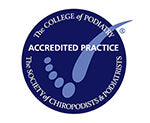INGROWN TOENAIL TREATMENT
Welcome to our page dedicated to providing information about ingrown toenail removal. At City Foot Health, we understand how uncomfortable and painful an ingrown toenail can be, which is why we offer a range of treatments to provide relief and ensure that you can return to your normal activities as soon as possible.
Why do ingrown toenails happen?
Ingrown toenails occur when the edge of a toenail grows into the skin surrounding the nail, causing redness, swelling, and pain. If left untreated, an ingrown toenail can lead to infection and further complications.
At City Foot Health, our team of highly qualified podiatrists can provide expert care and advice on the most suitable treatment for your individual needs. We offer both conservative and surgical treatments for ingrown toenails, depending on the severity of the condition.
What treatments are available for ingrown toenails?
Conservative treatments include nail trimming, lifting, and packing with specialist materials to encourage the nail to grow correctly. In some cases, we may recommend medication to reduce inflammation and pain.
For more severe cases, surgical intervention may be required. Our team of podiatrists are highly experienced in performing ingrown toenail removal procedures, which are performed under local anaesthetic to ensure your comfort throughout the process. After the procedure, we provide comprehensive aftercare instructions to ensure a speedy recovery.
We are dedicated to providing our patients with the highest level of care and attention, and we pride ourselves on delivering effective and long-lasting solutions to alleviate the discomfort and pain caused by ingrown toenails.
Get in touch with City Foot Health today
If you are experiencing the discomfort of an ingrown toenail, don't suffer in silence. Contact us today to book an appointment with one of our expert podiatrists and find relief through our ingrown toenail removal treatments.


Foot Treatments in London







